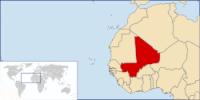|
|
|
Mali consists of eight regions and its borders on the north reach deep into the middle of the Sahara, while the country's southern region, where the majority of inhabitants live, features the Niger and Sénégal rivers. The country's economic structure centers around agriculture and fishing. Some of Mali's natural resources include gold, uranium, and salt. Present-day Mali was once part of three West African empires that controlled trans-Saharan trade: the Ghana Empire, the Mali Empire (from which Mali is named), and the Songhai Empire. In the late 19th century, during the Scramble for Africa, France seized control of Mali making it a part of French Sudan. French Sudan (then known as the Sudanese Republic) joined with Senegal in 1959, achieving independence in 1960 as the Mali Federation. Shortly thereafter, following Senegal's withdrawal from the federation, the Sudanese Republic declared itself the independent Republic of Mali. After a long period of one-party rule, a 1991 coup led to the writing of a new constitution and the establishment of Mali as a democratic, multi-party state. About half the population live below the international poverty line of US$1.25 a day. |




 RSS
RSS